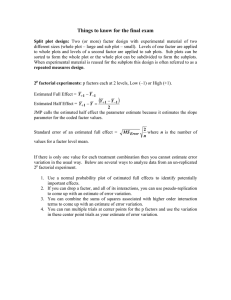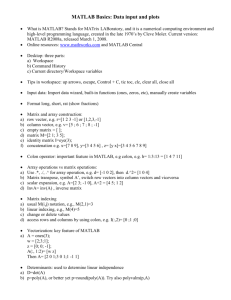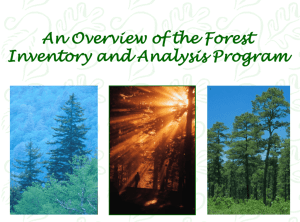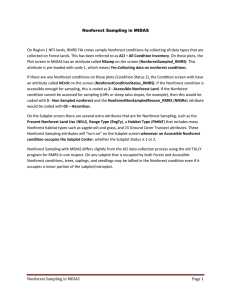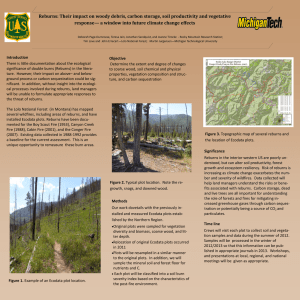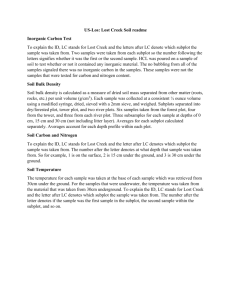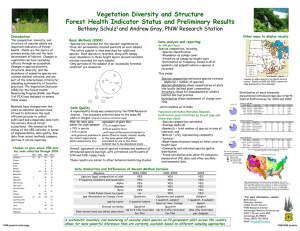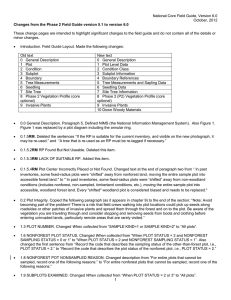National Core Field Guide, Version 7.0 January, 2016
advertisement
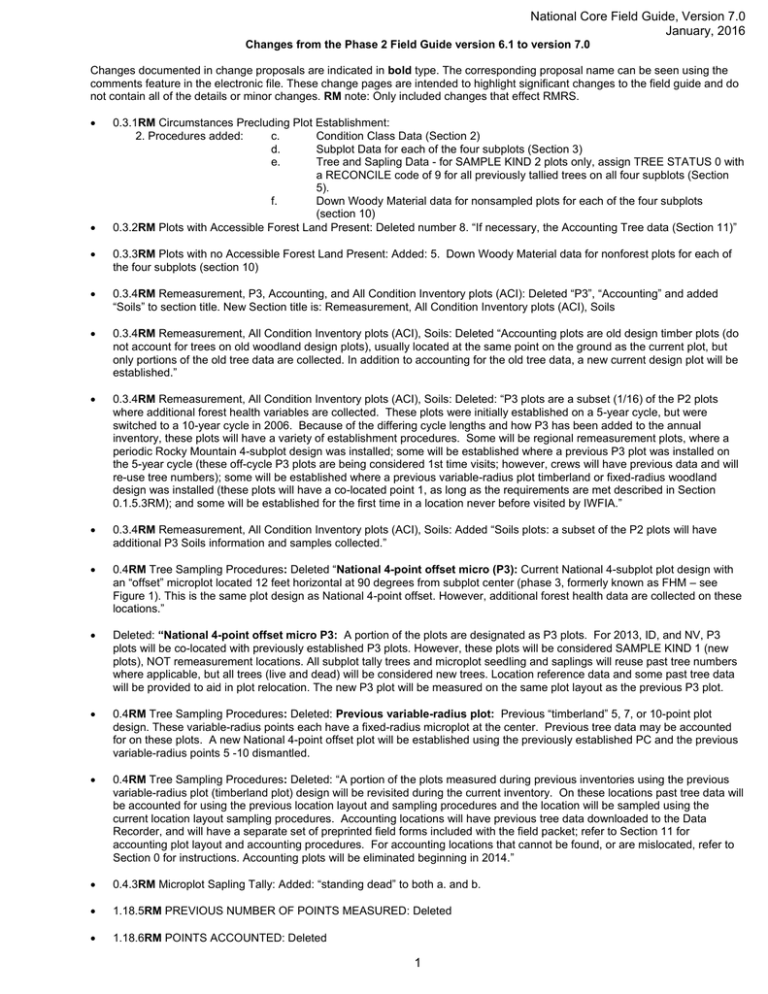
National Core Field Guide, Version 7.0 January, 2016 Changes from the Phase 2 Field Guide version 6.1 to version 7.0 Changes documented in change proposals are indicated in bold type. The corresponding proposal name can be seen using the comments feature in the electronic file. These change pages are intended to highlight significant changes to the field guide and do not contain all of the details or minor changes. RM note: Only included changes that effect RMRS. 0.3.1RM Circumstances Precluding Plot Establishment: 2. Procedures added: c. Condition Class Data (Section 2) d. Subplot Data for each of the four subplots (Section 3) e. Tree and Sapling Data - for SAMPLE KIND 2 plots only, assign TREE STATUS 0 with a RECONCILE code of 9 for all previously tallied trees on all four supblots (Section 5). f. Down Woody Material data for nonsampled plots for each of the four subplots (section 10) 0.3.2RM Plots with Accessible Forest Land Present: Deleted number 8. “If necessary, the Accounting Tree data (Section 11)” 0.3.3RM Plots with no Accessible Forest Land Present: Added: 5. Down Woody Material data for nonforest plots for each of the four subplots (section 10) 0.3.4RM Remeasurement, P3, Accounting, and All Condition Inventory plots (ACI): Deleted “P3”, “Accounting” and added “Soils” to section title. New Section title is: Remeasurement, All Condition Inventory plots (ACI), Soils 0.3.4RM Remeasurement, All Condition Inventory plots (ACI), Soils: Deleted “Accounting plots are old design timber plots (do not account for trees on old woodland design plots), usually located at the same point on the ground as the current plot, but only portions of the old tree data are collected. In addition to accounting for the old tree data, a new current design plot will be established.” 0.3.4RM Remeasurement, All Condition Inventory plots (ACI), Soils: Deleted: “P3 plots are a subset (1/16) of the P2 plots where additional forest health variables are collected. These plots were initially established on a 5-year cycle, but were switched to a 10-year cycle in 2006. Because of the differing cycle lengths and how P3 has been added to the annual inventory, these plots will have a variety of establishment procedures. Some will be regional remeasurement plots, where a periodic Rocky Mountain 4-subplot design was installed; some will be established where a previous P3 plot was installed on the 5-year cycle (these off-cycle P3 plots are being considered 1st time visits; however, crews will have previous data and will re-use tree numbers); some will be established where a previous variable-radius plot timberland or fixed-radius woodland design was installed (these plots will have a co-located point 1, as long as the requirements are met described in Section 0.1.5.3RM); and some will be established for the first time in a location never before visited by IWFIA.” 0.3.4RM Remeasurement, All Condition Inventory plots (ACI), Soils: Added “Soils plots: a subset of the P2 plots will have additional P3 Soils information and samples collected.” 0.4RM Tree Sampling Procedures: Deleted “National 4-point offset micro (P3): Current National 4-subplot plot design with an “offset” microplot located 12 feet horizontal at 90 degrees from subplot center (phase 3, formerly known as FHM – see Figure 1). This is the same plot design as National 4-point offset. However, additional forest health data are collected on these locations.” Deleted: “National 4-point offset micro P3: A portion of the plots are designated as P3 plots. For 2013, ID, and NV, P3 plots will be co-located with previously established P3 plots. However, these plots will be considered SAMPLE KIND 1 (new plots), NOT remeasurement locations. All subplot tally trees and microplot seedling and saplings will reuse past tree numbers where applicable, but all trees (live and dead) will be considered new trees. Location reference data and some past tree data will be provided to aid in plot relocation. The new P3 plot will be measured on the same plot layout as the previous P3 plot. 0.4RM Tree Sampling Procedures: Deleted: Previous variable-radius plot: Previous “timberland” 5, 7, or 10-point plot design. These variable-radius points each have a fixed-radius microplot at the center. Previous tree data may be accounted for on these plots. A new National 4-point offset plot will be established using the previously established PC and the previous variable-radius points 5 -10 dismantled. 0.4RM Tree Sampling Procedures: Deleted: “A portion of the plots measured during previous inventories using the previous variable-radius plot (timberland plot) design will be revisited during the current inventory. On these locations past tree data will be accounted for using the previous location layout and sampling procedures and the location will be sampled using the current location layout sampling procedures. Accounting locations will have previous tree data downloaded to the Data Recorder, and will have a separate set of preprinted field forms included with the field packet; refer to Section 11 for accounting plot layout and accounting procedures. For accounting locations that cannot be found, or are mislocated, refer to Section 0 for instructions. Accounting plots will be eliminated beginning in 2014.” 0.4.3RM Microplot Sapling Tally: Added: “standing dead” to both a. and b. 1.18.5RM PREVIOUS NUMBER OF POINTS MEASURED: Deleted 1.18.6RM POINTS ACCOUNTED: Deleted 1 National Core Field Guide, Version 7.0 January, 2016 1.18.7RM PREVIOUS NUMBER OF MICROPLOTS MEASURED: Deleted 1.18.8RM MICROPLOTS ACCOUNTED: Deleted 1.18.9RM ACCOUNTING LAND USE: Deleted 1.18.5RM FIELD LOCATION AND BOUNDARY MAP: Deleted 1.12 FIELD GUIDE VERSION. Changed Values from “6.0” to “7.0”. 1.19.2 Collected Readings. Modified introductory text. 1.19.3 GPS UNIT. Deleted code 1 and modified text of codes 2, 3, and 4. 1.19.14 AZIMUTH TO PLOT CENTER. Modified the When collected from “When GPS UNIT = 1, 2, 3, or 4” to “When GPS UNIT = 2, 3, or 4”. 1.19.15 DISTANCE TO PLOT CENTER. Modified the When collected from “When GPS UNIT = 1, 2, 3, or 4” to “When GPS UNIT = 2, 3, or 4”. 1.19.16 GPS ELEVATION. Modified the When collected from “When GPS UNIT = 1, 2 or 4” to “When GPS UNIT = 2 or 4”. 1.19.17 GPS ERROR. Deleted the following text: “As described in Section 1.19.2, make every effort to collect readings only when the error less than or equal to 70 feet. However, if after trying several different times during the day, at several different locations, this is not possible, record readings with an error of” and “071 to 999 if an error of less than 70 cannot be obtained”. Modified the When collected from “When GPS UNIT = 1 or 2” to “When GPS UNIT = 2”. 1.19.18 NUMBER OF READINGS. Modified the When collected from “When GPS UNIT = 1 or 2” to “When GPS UNIT = 2”. 2.3.1 Forest Land. The page numbers associated with the attributes of interest were corrected for current content. 2.3.2 Nonforest Land. The page numbers associated with the attributes of interest were corrected for current content. 2.5.7 OWNER. This variable was deleted in version 6.0 but left as a placeholder until version 7.0. It is repeated here for the convenience of the user. All the variables after the deleted variable have been renumbered. 2.5.10 ADMINISTRATIVELY WITHDRAWN AREA NAME. Corrected this variable to be listed as CORE OPTIONAL. This correction is consistent with the intent of the original change proposal for version 6.0 (Reserve_AdminWithdrawn_Change_proposal2.doc) 2.5.29.1RM LAND USE: Changed the codes from 3 digits to 1 digit. 2.5.30 added: CANOPY COVER SAMPLE METHOD: added RM figure 14a and figure RM 14b with figure explanation/description 5.0 Tree and Sapling Data. Introductory paragraphs. Added standing dead saplings to definition of tally sapling and modified the text to reflect this by changing “5.0 inches” to “1.0 inch”. Also corrected the text in the first bullet under the paragraph starting “The following apply at remeasurement:” 5.1 SUBPLOT NUMBER. Modified the When collected for saplings. 5.2 TREE RECORD NUMBER. Modified the When collected for saplings. 5.4 AZIMUTH. Modified the When collected for saplings. 5.5 HORIZONTAL DISTANCE. Modified the When collected for saplings. 5.7 PRESENT TREE STATUS. Modified the When collected for saplings. Also modified the text of code 2 – dead tree, and the note listed under the list of codes. 5.7.1 RECONCILE. Modified the When collected for saplings. Also added a new table, which is an abbreviated table from appendix 8, describing how to tally standing dead saplings with respective PRESENT TREE STATUS, RECONCILE CODE, and STANDING DEAD, which are being collected for the first time in Field Guide version 7.0. 5.7.1 RECONCILE. The following text was added to codes 3 and 4 in version 6.1 and repeated here for the convenience of the user: “Includes previously nonsampled subplots.” 2 National Core Field Guide, Version 7.0 January, 2016 5.7.2 STANDING DEAD. Modified the descriptive text for saplings. Also modified the captions for figures 20-22 for saplings. 5.7.3 MORTALITY. Modified the text and the When collected for saplings. 5.8 SPECIES. Modified the When collected for saplings. 5.9 DIAMETER. Deleted the following text from the introductory text: “Macroplot tree diameter thresholds are determined according to regional specifications (see regional field guides for more information).” Also modified the When collected and Tolerance for saplings. 5.9.2 DIAMETER AT BREAST HEIGHT (DBH). Corrected several figure references in the text. 5.12 DIAMETER CHECK. Modified the When collected for saplings. 5.14 TOTAL LENGTH. Modified the When collected for saplings. Also corrected the Values from “005 to 400” to “001 to 400”. 5.15 ACTUAL LENGTH. Modified the When collected for saplings. Also corrected the Values from “005 to 400” to “001 to 400”. 5.16 LENGTH METHOD. Modified the When collected for saplings. 5.20.1 DAMAGE AGENT 1. The following text was added in version 6.1 and is repeated here for the convenience of the user: “Note: in some cases, thresholds for specific agents may be different from the threshold for the corresponding general agent. If a region is collecting a specific insect agent and no one is collecting the general agent, then the specific insect agent is collapsed into the general insect category 10000.” Also, added text to the general agent column for code 13000. 5.23 DECAY CLASS. Modified the text and the When collected for saplings. 8.0 Phase 2 (P2) Vegetation Profile (Core Optional). The introductory text was clarified. 8.3.2 LEVEL OF DETAIL. Modified the text in codes 2 and 3. 8.6.1 SPECIES GROWTH HABIT. The text was modified. All five codes were also revised. 8.6.4 SPECIES CANOPY COVER. The introductory text was modified. Section 11.0RM ACCOUNTING PROCEDURES: Deleted this whole Section Section 12.0RM FIELD LOCATION REFERENCE FORM AND PLOT MONUMENTATION RECORDS: Renumbered this as Section 11.0RM Appendix 1. State and County, Parish, or Borough FIPS Codes. Added the county codes for the following Pacific islands: 60 – American Samoa; 64 – Federated States of Micronesia; 66 – Guam; 68 – Marshall Islands; 69 – Northern Mariana Islands; and 70 – Palau. Appendix 2. FIA Forest Type Codes. Added code 988 and description. Modified code names of codes 982, 987, and 989 to match the names in the FIA database. Appendix 7. Tolerance/MQO/VALUE/Units Table. Updated this appendix based on changes in the rest of the document. Appendix 8. Tree Coding Guide. Updated this appendix for changes in sapling measurement. Appendix 11. Damage Codes. The following changes were made in version 6.1 and are repeated here for the convenience of the user. The sixth column heading was changed from “New Category?” to “General Category Designation”. The following changes were made to the appendix: Code 22002 22003 41003 41005 41006 90010 Old Threshold Any visual evidence Any visual evidence New Threshold Old REGION New REGION (no change) (no change) (no change) (no change) IW IW IW ALL IW; PNW IW; PNW IW; PNW IW; PNW; NRS 3 National Core Field Guide, Version 7.0 January, 2016 Appendix 11. Damage Codes. The following damage codes were modified in version 7.0 according to the damage code change procedure. Changes to the damage code list were proposed according to the accepted procedure, and discussed and approved at the DAB meeting, Feb. 2015 in Portland, OR. Code 11006 11030 Old Threshold New Threshold Old REGION IW IW; SRS New REGION IW; NRS IW; NRS; SRS Changes from the Reorganization of the Field Guide Several variables were moved from their original locations to a different chapter of the field guide to more closely match the data collection program. These changes are summarized in the following table: New variable number Variable name Original variable number 1.22 (Plot Level Data chapter) P2 Vegetation Sampling Options introductory material 8.3 1.22.1 P2VEGETATION SAMPLING STATUS 8.3.1 1.22.2 LEVEL OF DETAIL 8.3.2 1.23 INVASIVE PLANT SAMPLING STATUS (Plot-level variable) 9.3 1.24 INVASIVE PLANT SPECIMEN COLLECTION RULE (Plot-level variable) 9.12 1.25 DWM introductory material 10.3 1.25.1 DWM SAMPLING STATUS (BASE) 10.3.1 1.25.2 DWM NUMBER OF SUBPLOTS (BASE) 10.3.2 1.25.3 DWM NUMBER OF TRANSECTS ON SUBPLOT (BASE) 10.3.3 1.25.4 DWM TRANSECT LENGTH (BASE) 10.3.5 1.25.6 DWM NOTES (BASE) 10.3.5 2.6.1 (Condition Class chapter) CONDITION FUELBED TYPE (OPTIONAL) 10.4.1 3.12( Subplot Information chapter) P2VEG SUBPLOT SAMPLE STATUS 8.4.2 3.13 VEGETATION NONSAMPLED REASON 8.4.3 3.14 VEGETATION SUBPLOT NOTES 8.4.5 3.15 INVASIVE PLANT SUBPLOT SAMPLE STATUS (Subplot-level variable) 9.5 3.16 INVASIVE PLANT NONSAMPLED REASON (Subplot-level variable) 9.6 3.17 INVASIVE PLANT DATA NOTES 9.7 The sections were renumbered after the variables were moved. References to specific sections in the text were also changed to match the new section numbers. Deleted all the When collected, Field width, Tolerance, and MQO information from the variables. This information now all resides in appendix 7. 1.22.1 (old 8.3.1) P2 VEGETATION SAMPLING STATUS. Modified the last sentence to match the relocation of the variable. 1.25.5 DWM SUBPLOT LIST (BASE). Added this variable to match the data collection program. Figure 21 in chapter 5 was replaced with a new figure. 5.24 LENGTH TO DIAMETER MEASUREMENT POINT (CORE OPTIONAL). The When collected was corrected (see table below). 4 National Core Field Guide, Version 7.0 January, 2016 10.6.9 (old10.8.9).HIGHCOUNT REASON (BASE). Modified the text to match the When collected. Changed “Enter a code if any of the counts on the transect are greater than 100 pieces.” to “Enter a code if any of the counts on the transect are greater than or equal to 100 pieces.” The When collected statements were condensed for several variables as shown in the table below: Item # 1.15 Variable name HORIZONTAL DISTANCE TO IMPROVED ROAD 1.16 WATER ON PLOT 1.22.2 (8.3.2) LEVEL OF DETAIL 2.5.1 RESERVED STATUS 2.5.2 OWNER GROUP 2.5.4 STAND SIZE CLASS 2.5.5 REGENERATION STATUS 2.5.6 TREE DENSITY 2.5.7 OWNER CLASS 2.5.8 OWNER SUB-CLASS 2.5.13 ARTIFICIAL REGENERATION SPECIES 2.5.14 STAND AGE 2.5.15 2.5.17 2.5.19 DISTURBANCE 1 DISTURBANCE 2 DISTURBANCE 3 Old when collected All plots with either one accessible forest land condition class (PLOT STATUS = 1) or one accessible nonforest land condition class when nonforest is field-measured (PLOT STATUS = 2 and NONFOREST SAMPLING STATUS = 1 and NONFOREST PLOT STATUS =1) All plots with either at least one accessible forest land condition class (PLOT STATUS = 1) or one accessible nonforest land condition class when nonforest is fieldmeasured (PLOT STATUS = 2 and NONFOREST SAMPLING STATUS = 1 and NONFOREST PLOT STATUS = 1) On all plots where P2 Vegetation is being sampled (P2 VEGETATION SAMPLING STATUS = 1 or 2) CORE: All accessible forest land condition classes (CONDITION CLASS STATUS = 1) CORE OPTIONAL: All condition classes CORE: All accessible forest land condition classes (CONDITION CLASS STATUS = 1) CORE OPTIONAL: All condition classes All accessible forest land condition classes (CONDITION CLASS STATUS = 1) All accessible forest land condition classes (CONDITION CLASS STATUS = 1) All accessible forest land condition classes (CONDITION CLASS STATUS = 1) CORE: All accessible forest land condition classes (CONDITION CLASS STATUS = 1) CORE OPTIONAL: All condition classes State owned condition classes (OWNER CLASS = 31) All accessible forest land condition classes (CONDITION CLASS STATUS = 1) with evidence of artificial regeneration (REGENERATION STATUS = 1) All accessible forest land condition classes (CONDITION CLASS STATUS = 1) All accessible forest land condition classes (CONDITION CLASS STATUS = 1) or accessible nonforest condition classes when nonforest is being sampled 5 New when collected When PLOT STATUS = 1 or PLOT STATUS = 2 and NONFOREST SAMPLING STATUS = 1 and NONFOREST PLOT STATUS =1 When PLOT STATUS = 1 or PLOT STATUS = 2 and NONFOREST SAMPLING STATUS = 1 and NONFOREST PLOT STATUS = 1 When P2 VEGETATION SAMPLING STATUS = 1 or 2 CORE: CONDITION CLASS STATUS = 1 CORE OPTIONAL: All condition classes CORE: (CONDITION CLASS STATUS = 1) CORE OPTIONAL: All condition classes When CONDITION CLASS STATUS = 1 When CONDITION CLASS STATUS = 1 When CONDITION CLASS STATUS = 1 CORE: When CONDITION CLASS STATUS = 1 CORE OPTIONAL: All condition classes OWNER CLASS = 31 When CONDITION CLASS STATUS = 1 and REGENERATION STATUS = 1 When CONDITION CLASS STATUS = 1 When CONDITION CLASS STATUS = 1 or NONFOREST SAMPLING STATUS = 1 and NONFOREST CONDITION CLASS STATUS = 2 National Core Field Guide, Version 7.0 January, 2016 Item # Variable name 2.5.21 2.5.23 2.5.25 3.8 TREATMENT 1 TREATMENT 2 TREATMENT 3 SUBPLOT SLOPE 3.9 SUBPLOT ASPECT 3.10 SNOW/WATER DEPTH 3.12 (8.4.2) P2 VEG SUBPLOT SAMPLE STATUS 5.6 PREVIOUS TREE STATUS 5.24 LENGTH TO DIAMETER MEASUREMENT POINT (CORE OPTIONAL) Old when collected (NONFOREST CONDITION CLASS STATUS = 2) All accessible forest land condition classes (CONDITION CLASS STATUS = 1) All subplots with at least one accessible forest land condition present on subplot (SUBPLOT/MACROPLOT STATUS = 1) or subplots with an accessible nonforest condition class present when nonforest is being sampled (NONFOREST SUBPLOT/MACROPLOT STATUS = 1) : All subplots with at least one accessible forest land condition present on subplot (SUBPLOT/MACROPLOT STATUS = 1) or subplots with an accessible nonforest condition class present when nonforest is being sampled (NONFOREST SUBPLOT/MACROPLOT STATUS = 1) All subplots with at least one accessible forest land condition present on subplot (SUBPLOT/MACROPLOT PLOT STATUS = 1) or subplots with an accessible Nonforest condition class present when Nonforest is being sampled (NONFOREST SUBPLOT/MACROPLOT STATUS = 1) On all subplots where P2 Vegetation is being sampled on accessible forest land (P2 VEGETATION SAMPLING STATUS=1) and at least one accessible forest land condition (CONDITION CLASS STATUS = 1) exists within the 24-foot radius subplot, or P2 Vegetation is being sampled on all accessible land conditions (P2 VEGETATION SAMPLING STATUS=2) and at least one accessible forest condition or measurable nonforest condition (CONDITION CLASS STATUS = 1 or NONFOREST CONDITION CLASS STATUS = 2) exists within the 24-foot radius subplot All new live and standing dead tally trees > 1.0 inch DBH/DRC On remeasurement plots, all previously tallied trees CORE OPTIONAL: All live and dead tally trees (except woodland species) ≥ 1.0 inch DBH New when collected When CONDITION CLASS STATUS = 1 When SUBPLOT/MACROPLOT STATUS = 1 or NONFOREST SUBPLOT/MACROPLOT STATUS = 1 When SUBPLOT/MACROPLOT STATUS = 1 or NONFOREST SUBPLOT/MACROPLOT STATUS = 1 When SUBPLOT/MACROPLOT STATUS = 1 or NONFOREST SUBPLOT/MACROPLOT STATUS = 1) When P2 VEGETATION SAMPLING STATUS=1 and at least one accessible forest land condition (CONDITION CLASS STATUS = 1) exists within the 24-foot radius subplot, or P2 VEGETATION SAMPLING STATUS=2 and at least one accessible forest condition or measurable nonforest condition (CONDITION CLASS STATUS = 1 or NONFOREST CONDITION CLASS STATUS = 2) exists within the 24-foot radius subplot. On SAMPLE KIND = 2, all previously tallied trees ≥ 1.0 inch DBH CORE OPTIONAL: All live and standing dead tally trees (except woodland species) ≥ 1.0 inch DBH Appendix 13. Ownership Prefield Procedures. Revised format of table in section A13.57.3 for readability. E.5.1 ACI RANGE TYPE: Added Range Type values to Appendix E 6 National Core Field Guide, Version 7.0 January, 2016 E.5.2ACI Habitat Type Reference Bibliography (detailed reference citation): Literature Cited available upon request. Added “available upon request” and removed the literature cited. P3 Soil Measurement and Sampling: Changed the soil shipping address on the Soil Shipping Form P3 Soil Measurement and Sampling: Deleted the acknowledgements 7


